Preliminary draft
1st copy , needs further editing - not ready yet.
Introduction
Background and development
History
Although I have no clue whether Nikon was the first who has pioneered the zoom range of 80-200mm (but Nippon Kokagu (old name of Nikon Corporation)'s first zoom lens, 8.5~25.0cm (85-250mm) f/4~4.5-16 Zoom-Nikkor Auto of 1960 did came close with this focal length in the early days of zoom photography. However, regardless whether the Company was the first to introduce the 80-200mm range but few would doubt the fact it was the 1969's Non-Ai Zoom Nikkor Auto 1:4.5 f=80mm~f=200mm which has changed the course of lens development and the perception of photographers who had so much reservation for the zoom lens type. General, photographers thought zoom lenses were too inferior in their optical performance for serious photography. The 80-200mm has actually went through a few major updates, with an Ai version in 1977 in accordance with the broad scale Nikkor Ai-lens updating program. The 1981's revision involved external and internally, the lens speed of the manual focus Zoom Nikkor 80-200mm f/4.0s has been stepped up to a slightly faster f/4.0 lens speed where a new 13 elements 9 groups optical structure was used. Further, the zoom has a native Ai-S lens configuration, making it compatible with some of the MF Nikon bodies as well as early series of AF Nikon SLRs when high speed program AE and Shutter Priority AE modes are activated. Similarly, the update also extends its usage for Nikon's early AMP (Automatic Multi-Pattern Metering (Matrix) system, first introduced with the Nikon FA in 1983.
 |
||
|
Nikkor
Zoom Auto 1:4.5 f=80mm~f=200mm
|
Zoom Nikkor 80-200mm f/4.5 Ai July, 1977 |
Zoom Nikkor 80-200mm f/4.0s Ai-S August, 1981 |
The above briefly described how the Nikkor Zoom 80-200mm presents itself with a slower starting aperture of f/4.5 and f/4.0 evolved itself in few change. The 80-200mm with a full f-stop faster in lens speed at f/2.8 actually began development way back after Nikon has converted their lens system to Ai in 1977. A prototype of a magnificent MANUAL FOCUS Zoom-Nikkor 80-200mm f/2.8 ED lens was shown during Photokina in 1978. The zoom came used a dual rings control design for zooming and focusing. However, due to unknown reasons, the lens has never been marketed but it was not until August 1982 -the photo community finally witnessed a workable solution of a true fast speed Zoom Nikkor 80-200mm f/2.8s ED lens; this version has a different in a similar configuration from the prototype where a one-touch sliding zoom designed was adopted.
 |
 |
Although we believe the sliding f/2.8 MF zoom was never been sold in big quantity as comparable to the version with a slower f/4.5 or the f/4.0 aperture, but this magnificent manual focus Zoom Nikkor 80-200mm f/2.8s ED has formed the basis of the beginning of a new era for high performance, large aperture zoom lenses that commonly found today in every professional camera gears selection. |
Part I Nikon's AF Zoom Nikkor 80-200mm f/2.8s
ED MK I Telephoto
Zoom lens
Year
introduced: February, 1988; Discontinued: Sept. 1992
The AF Zoom-Nikkor 80-200mm f/2.8 ED can be considered as the first among the many versions of the classic AF Nikkor 80-200mm f/2.8 fast speed zoom lenses introduced during the last 20 years. Nikon didn't included this fabulous zoom lens in their first generation of the Nikkor autofocus lenses and photographers who may anticipate a slowly AF 80-200mm f/4.0 was rather surprised to find Nikon introduced with this large aperture zoom instead. Well, one of the reason could be the replacement unit (MF Zoom-Nikkor 80-200mm f/4.0S) for the famed MF Zoom Nikkor 80-200mm f/4.5 didn't get the expected reaction from photographers. So, when Nikon introduced their AF system in 1986, they opted for an alternate AF Zoom Nikkor 70-210mm f/4.0s zoom for the slower lens speed category and used the 80/200 f/2.8 as their primary asset in the early AF Nikkor lens group. Technically from a commercial perspective, the 70-210mm has 10mm at its startup focal length and extends 10mm at the other longer focal length which Nikon thought it should appeal more to photographers but it was not a successful attempt commercially - I guess this has very much due to the fact where photographers often like to relate it with the poor physical quality exhibited in the Series E 70-210mm, although I thought that was quite a performer optically. But from a personal point of view, the AF 70-210mm has a far superior built quality as compared to the MF 70-210mm series E zoom.
The professional grade AF Zoom-Nikkor 80-200mm f/2.8S ED was actually introduced as part of a marketing element to support launching of the 4th generation of the single-digit F model, Nikon F4(s) in 1988. So, it carries a professional appeal to specific group of users rather than intended to serve mass segment. Although both of these MF and AF fast speed zoom lenses seemingly carried with identical lens designation, the Autofocus (AF) Zoom has been designed with a different lens spec from the Manual Focus ED 80/200 zoom. Primarily because it has been designed as an autofocus zoom from ground up. Basic lens operation remains as an one-touch sliding zoom but it has a fixed lens barrel at the front end to accommodate distance scales display in a concealed window. Externally, the familiar gold ring that signifies an ED lens element was used inside the optical group has been replaced with a gold lens data plate near the focusing window. |
 |
|
Embodies inside this relatively large and heavy piece of zoom lens is a 16 elements in 11 groups optical structure where Nikon generously used three ED glass lens elements inside the optical train (2nd, 3rd and 13th) to suppress chromatic aberration which is commonly found on large aperture telephoto zoom lenses. Please take note that the MANUAL FOCUS 80/200mm f/2.8S ED actually has a different optical construction of 15E/11G and hence, this AF Zoom has been redesigned internally with a new optical composition. The change has seemingly delivered an outstanding optical performance and laid the foundation in the birth of another optical classic in the Nikkor lens family. The zoom lens also has a provision for close range correction system employed within. The Close Range Correction ("CRC") ensures its excellent optical quality to be retained even when it is used at its closest focusing distances. The minimum focus range is active from 1.8m (5.9 ft) down to 1.5m (approx. 4.9 ft) ; at such close focus distances, the zoom can deliver a maximum reproduction ratio of 1:5.9X ! Nikon has not designed the lens with an Internal Focus (IF) in this version. The focusing from infinity to its minimum focus is represented by an orange line with an alphabet " M " after the marked minimum focus is achieved. The close focusing capability and high quality performance of this Nikkor zoom has also certainly expands its versatility for photographers. As many possible photographic applications such as in and out of studio, location shoot in low available light shootings which partly contributed to its wide acceptance. More importantly, it has supplemented the the professional Nikon F4 system with a more lens varieties to choose from.
 |
As large aperture lenses usually are closely associated with an enlarged dimension and weight for a lens and inevitably it affects mobility. This fast speed Nikkor zoom lens measures 85.5mm x 176.5mm and weighs almost 1,220g (approx. 2 Ibs 10.3 oz) ! So when combines it with a typically pro-calibre Nikon SLR such as Nikon F4s with a bare basic body weight of 1,280g (45.1 oz. with High Speed Battery Pack MB-21) - it can be physically very demanding for photographers who may be on the constant move for photographic assignments. Although it balances well in such a combination, the weight factor may also attributes to other secondary issues such as stability during shooting etc.. So, one of the point where photographers always complained about this lens was the lack of a built in tripod collar like the design found on the manual focus (MF) 80-200mm f/2.8s ED. |
Physically, you can easily rated both built quality and workmanship of this zoom as a top class zoom lens where I have nothing to complaint about. The lens handling may be a little tricky as Nikon possibly realized the weakness in the early AF system for their camera models and thence they have designed this zoom lens with a built-in focus limiter in rotating ring form. This feature provides focal length range control. The benefit is to provide a quicker access to a desired working focus distances as well as serves to conserve power. The ring can be set from FULL (assuming you don't bother), OO~3m (10 ft) and OO~5m (15 ft). Another control is an A/M switch which is set for either operate the lens in AF or MF mode. For those who may get accustomed to a colorful visual display of depth of field indicative lines that is commonly found on older manual focus Nikkor zoom lenses - sorry. Nikon has totally eliminated this lovely feature and neither the focusing window has any clue on how depth of field ("DOF") is judged visually. For this, Nikon expects photographers to make us of the camera's built-in DOF preview function. Replacing the DOF scales is a tiny dot that marked 80mm just for indicative infrared compensation. Other minor feature is the Minimum Aperture Lock which uses a Twisted and Turn design knob, it is a feature commonly found on early version of AF Nikkor lenses where you can also use this as a verification method for the different versions of this fast speed Nikkor zoom lens as most of the AF Nikkor lenses introduced at later stages replaced this with a slide switch design.
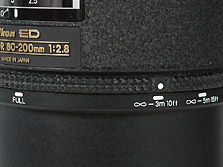 |
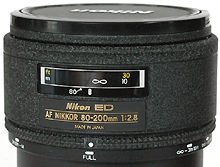 |
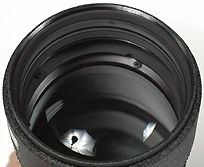 |
Credit: Image courtesy of PDQ INTERNET MARKET PLACE where I found these lovely images from his PDQ@EBAY Store®. Image copyright © 2006. All rights reserved. Please respect the visual property of the contributing photographer. |
Lens handling and zoom control for this AF Zoom-Nikkor 80-200mm f/2.8S ED lens can be easily rated as a class A performer. Overall image resolution from near to far in its zoom range equally is impressive for a zoom. The incorporation of multiple ED glass elements as well as Nikon Integrated Lens Coating (NIC) has certainly delivered its purpose for this zoom where images captured generally exhibiting consistently sharp and contrasty images as a whole. In particular, for pictures scenes that contains blue and red elements, the color correction is visibly apparent. Although personally I thought focal length to focal length, the zoom may not be as sharp as comparing to a equivalent prime Nikkor telephoto, but the sheer convenience it provides as a zoom will make you feel very forgiving on other minor aspects.
Due to its extraordinary light gathering power, this high speed Nikkor zoom uses an odd diameter of 77mm filter attachment size, Nikon has designed a dedicated bayonet lens hood HN-28 specifically for this Nikkor zoom lens during those early days. The HN-28 also has a common crinkle finish which makes a matching companion for overall presentation when mounted. The hood works effectively when shooting backlit scenes although it is considered to be quite large in size and may affect portability. The standard accessories with the lens includes a dedicated hard lens case CL-43. As the large aperture of the lens may encourage use of tele-converter to extends its functionality further, Nikon advised the compatible types for this particular version of the AF Nikkor 80-200 f/2.8s ED zoom is Nikon TC-14BS. The alternate TC-16AS, TC14AS and TC-201S may also be usable but Nikon advises that when shooting pictures at a combination of high shutter speeds with small apertures, occasionally uneven exposures may occur. Further, when used in conjunction with a Tele-Extender, other than it experiences a drop in effective lens speed (usually it means a drop in shutter speed); the combination will revert the autofocus zoom back to MANUAL FOCUS.
![]()
Technical
Specification
for Nikon AF Zoom-Nikkor 80-200mm
f/2.8s ED MK I telephoto Zoom lens:-
Type of lense: Autofocus Nikkor zoom lens with built-in CPU and a metal rear
Nikon bayonet mount
Focal length: 80mm to 200mm (approx. 123mm to 309mm (120-300mm) for Nikon
DX format DSLR camera)
Maximum aperture: f/2.8; Minimum Aperture: f/22
Lens construction: 16
elements in 11 groups;
x 3 ED elements at 2nd, 3rd and 13th, with close range correction (CRC) design
Picture angle: 30°
10'- 12°
20'; ' (7° 50'-19°
51' with
Nikon digital cameras (Nikon DX format))
Focal
length scale: 80mm, 105mm, 135mm and 200mm
Diaphragm: Fully automatic,
Focus/Zoom
control: Via single focusing/zoom ring
Distance scale: Graduated in meters and feet/inches from 1.8m (5.9 ft) at normal focus to infinity (OO); close focuses at its nearest distance at 1.4m (4.9') at MACRO mode |
Depth of Field Scales: NONE |
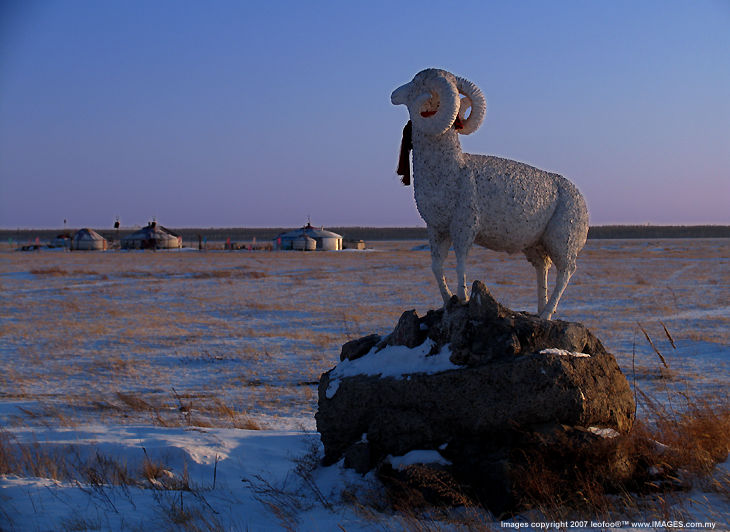 |
Nomad huts at remote Inner Mongolia, China. |
Dimensions:
Approx. 85.5mmmm dia. x 176.5mm (approx. 8"); overall length is approx. 184.5
mm
Weight: Approx.1,200g (2 IBs 10.3 oz)
Usable Tele-Converters:
- TC-14BS. When using TC-16AS, TC14AS and TC-201S (Note: operates in MANUAL focus
only) . Nikon advises using small aperture with high shuuter speed, occationally,
there may be uneven exposure. Similarly, slight vignetting may surface.
* Other information: A. Be careful not
to damage the CPU contacts. Do not attach the following accessories to the lens,
as they might damage the lens' CPU contacts: This lens cannot be used with AF Finder
DX-1 attached to the Nikon F3AF camera. Startup Serial Number for the Nikon AF Zoom Nikkor 80-200mm
f/2.8S ED zoom lens may have been began from: AF 80-200/2.8 ED 1 ring, 3 position focus limiter
5+ 200001 < 200887 - 375831 > Feb88 - Sep92 175831
Reference: Roland Vink's
lens data sheet.
| NEXT | 1/5
The second upgrade of Nikon
AF Zoom Nikkor 80-200mm f/2.8D ED (MK II)
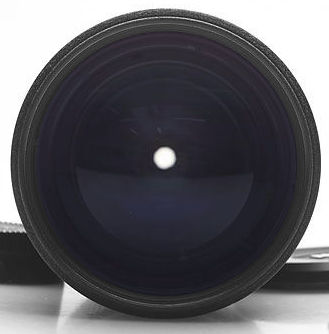 |
Page 1:- Original Version MK I (1988~1992) |
Credit: Image courtesy of Mr. Elle of www.PhoneBusta.co.uk®, U.K.. The Company also maintains an active Ebay Store, trading many photo equipment of various labels. Image(s) copyright © 2005. All rights reserved. Please respect the visual property of the contributing photographer.
RELATIVE: Manual Focus 8.5~25.0cm (85-250mm) f/4~4.5-16 Zoom-Nikkor Auto; Non-Ai Zoom Nikkor Auto 1:4.5 f=80mm~f=200mm; Zoom Nikkor 80-200mm f/4.5; Manual focus Zoom Nikkor 80-200mm f/4.0s; prototype of Manual Focus 80-200mm f/2.8 ED; Manual Focus Nikon Zoom Nikkor 80-200mm f/2.8s ED
Main Index Page - Autofocus Nikkor lenses
| Message Board |
for your
Nikkor
Optics
in a shared environment
| Message Board | Specifically for Dispose or Looking for new/used Nikon/Nikkor photographic equipment
| Nippon Kogaku Rangefinder Resources | Nikon F | Nikon F2 | Nikon F3 | Nikon F4 | Nikon F5 | Nikon F6 | Nikkormat / Nikomat | Nikon FM Series | Nikon FE/ FA | Nikon EM/FG/FG20 | Nikon Digital SLRs | Nikon - Other models |
Nikon MF RF-Nikkor lenses for Rangefinder
cameras:-
Main Index Page
Nikon
Auto Focus Nikkor lenses:- Main Index
Page
Nikon
Manual
Focus
Nikkor lenses:-
Fisheye-Nikkor Lenses - Circular |
Full Frame |
Ultrawides Lenses - 13mm15mm18mm20mm |
Wideangle Lenses - 24mm28mm35mm |
Standard Lenses - 45mm 50mm 58mm | Telephoto Lenses
- 85mm105mm135mm180mm & 200mm |
Super-Telephoto Lenses - 300mm 400mm 500mm 600mm 800mm 1200mm |
 |
Special Application
lenses: Micro-Nikkor Lenses - 50mm~55mm -60mm 85mm -105mm 200mm Micro-Zoom 70-180mm Perspective Control (PC) - 28mm 35mm PC-Micro 85mm Dedicated Lenses for Nikon F3AF: AF 80mm f/2.8 | AF 200mm f/3.5 EDIF Depth of Field Control (DC): 105mm 135mm Medical Nikkor: 120mm 200mm Reflex-Nikkor Lenses - 500mm 1000mm 2000mm Others: Noct Nikkor | OP-Nikkor | UV Nikkor 55mm 105mm | Focusing Units | Bellows-Nikkor 105mm 135mm Nikon Series E Lenses: 28mm35mm50mm100mm135mm | E-Series Zoom lenses: 36~72mm75~150mm70~210mm |
MF Zoom-Nikkor Lenses: 25~50mm | 28~45mm | 28~50mm | 28~85mm | 35~70mm | 36~72mm E | 35~85mm | 35~105mm | 35~135mm | 35~200mm | 43~86mm | 50~135mm | 50~300mm | 70~210mm E | 75~150mm E | 80~200mm | 85~250mm | 100~300mm | 180~600mm | 200~400mm | 200~600mm | 360~1200mm | 1200~1700mm
Tele-Converters: TC-1 | TC-2 | TC-200 | TC-201 | TC-300 | TC-301 | TC-14 | TC-14A | TC-14B | TC-14C | TC-14E | TC-16 | TC-16A | TC-20E
Recommended links to understand more technical details
related to the Nikkor F-mount and production Serial Number:
http://rick_oleson.tripod.com/index-153.html by: my
friend, Rick Oleson
http://www.zi.ku.dk/personal/lhhansen/photo/fmount.htm by: Hansen,
Lars Holst
http://www.mir.com.my/rb/photography/hardwares/nikonfmount/lens2.htm
http://www.photosynthesis.co.nz/nikon/serialno.html
Recommended Reading Reference on Nikon cameras and Nikkor lenses | about this photographic web site
| | Back | Main Index Page of Nikkor Resources | Back | Main Index Page of Pictorial History of Nikon SLRs |
| Home - Photography in Malaysia |
![]() Co-developed
with my web buddy, Rick Oleson® &
Co-developed
with my web buddy, Rick Oleson® & ![]() Denmark, Creator of the Nikon
Repair Group Mailing-List;
A
contributing effort to Michael Liu's Classic Nikon SLRs and
Nikkor optic site.
Denmark, Creator of the Nikon
Repair Group Mailing-List;
A
contributing effort to Michael Liu's Classic Nikon SLRs and
Nikkor optic site.
Credit: MCLau®, who has helped to rewrite
some of the content appeared this site. Chuck Hester® who has been helping
me all along with the development of all these Nikon websites; Lars Holst Hansen, 'Hawkeye'
who shares the same passion I have; Ms Rissa, Sales manager
from Nikon Corporation Malaysia for granting permission to use some of the official
content; Ted Wengelaar, Holland
who
has helped to provide many useful input relating to older Nikkor lenses; Some of the references
on production serial numbers used in this site were extracted from Roland Vink's website; Hiura Shinsaku from Nikomat
Club Japan. Lastly,
to all the good people who has contributed their own expeience, resources or kind
enough granted permission to use their images of their respective optic in this site.
It is also a site to remember a long
lost friend
on the Net. Note:certain content and
images appeared in this site were either scanned from official marketing leaflets
& brochures published by Nikon and/or contribution from surfers who claimed originality
of their work for educational purposes. The creator of the site will not be responsible
for may discrepancies arise from such dispute except rectifying them after verification. "Nikon", "Nikkormat", "Nippon Kokagu
KK"
& "Nikkor" are registered
tradename of Nikon Corporation Inc., Japan. Site made with an Apple IMac.


